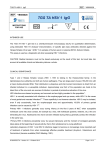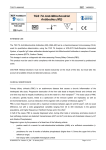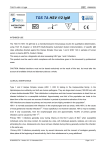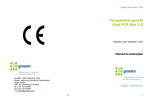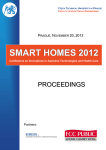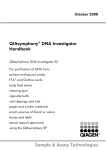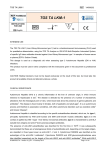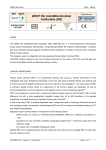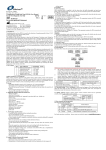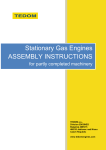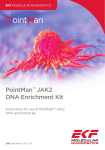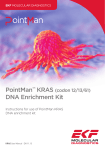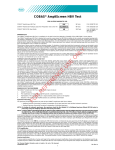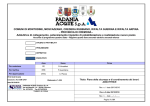Download TGS TA TOXO IgM - Technogenetics
Transcript
TGS TA TOXO IgM REF REF YB500033 YB500033 TGS TA TOXO IgM INSTRUCTIONS FOR USE 100 EN English 0459 INTENDED USE The TGS TA TOXO IgM test is a chemiluminescent two-step capture immunoassay (CLIA) for quantitative determination, using TGS TA Analyser or IDS-iSYS Multi-Discipline Automated System, of specific IgM class antibodies directed against the Toxoplasma gondii (TOXO) in samples of human serum or plasma (EDTA, Sodium Citrate). This assay is used as a diagnostic aid when assessing immunity status of patients related to Toxoplasmosis. This product must be used in strict compliance with the instructions given in this document by professional users. CAUTION: Medical decisions must not be based exclusively on the result of this test, but must take into account all available clinical and laboratory data as a whole. CLINICAL SIGNIFICANCE Toxoplasmosis is a parasitic disease caused by infection with the obligate intracellular protozoan 1 Toxoplasma gondii . The parasite infects most genera of warm-blooded animals, including humans, but the primary host is the felid (cat) family. Animals are infected by eating infected meat, by ingestion of feces of a 2 cat that has itself recently been infected, and by transmission from mother to fetus . Cats are the primary source of infection to human hosts, although contact with raw meat, especially pork, is a more significant 3 source of human infections in some countries. Fecal contamination of hands is a significant risk factor . 4 Toxoplasmosis is one of the most chronic infections affecting one third of the world’s human population . The prevalence of Toxoplasma gondii infection varies among different geographical regions. The infection is characterized by non-specific symptoms with the consequent formation of cysts that may remain in latent 5. form in many organs Primary infection is usually subclinical but in some patients cervical lymphadenopathy 6 or ocular disease can be present . There are four groups of individuals in whom the diagnosis of toxoplasmosis is most critical: pregnant women who acquire their infection during gestation, fetuses and newborns who are congenitally infected, immune compromised patients, and those with chorioretinitis 7,8,9 . Although these infections are usually either asymptomatic or associated with self-limited symptoms in adults (e.g., fever, malaise and lymphadenopathy), infections in pregnant women can cause serious health problems in the fetus if the parasites are transmitted (i.e., congenital toxoplasmosis) and cause severe sequelae in the infant including mental retardation, blindness and epilepsy. The most frequent challenge IFU044TGS TA – Version: 01_EN – 08 July 2014 Page 1 of 14 TGS TA TOXO IgM REF YB500033 encountered by physicians the world over is how to determine if a pregnant woman acquired the acute infection during gestation. Women who acquired their infection prior to pregnancy are essentially not at risk for delivering an infected infant (unless the woman is immunosuppressed). Furthermore, methods of diagnosis and their interpretations may differ for each clinical category. The diagnosis of Toxoplasma gondii infection may be established by serologic tests, amplification of specific nucleic acid sequences (PCR), histological demonstration of the parasite and/or its antigens or by isolation of 8 the organism . The use of serologic tests for demonstration of specific antibody to Toxoplasma gondii is the initial and primary method of diagnosis. Serological screening relies on IgG and IgM antibody determinations. The presence of elevated levels of Toxoplasma specific antibodies indicates infection has occurred at some point, but does not distinguish between an infection acquired recently and one acquired in 10 the distant past. In acute infection, IgG and IgM antibodies generally rise 1 to 2 weeks of infection . Detection of Toxoplasma specific IgM antibodies is so used as an aid in determining the time of infection, but 11 it is critical to remind that IgM antibodies have been reported to persist for up to 18 months post infection . To differentiate between a recently acquired infection and a past infection, IgM and IgG positive specimens should be tested for IgG avidity. A high avidity index for IgG antibodies is a strong indication that an infection took place more than 4-5 months ago 12,13,14 . PRINCIPLE OF THE METHOD The TGS TA TOXO IgM kit for quantitative determination of specific anti-Toxoplasma gondii IgM employs a capture two-step immunological method based on the principle of chemiluminescence. The specific antibody anti h-IgM is used to coat the magnetic particles (solid phase) and the specific antigen is labelled with an acridinium ester derivative (conjugate). During initial incubation, the IgM antibodies present in the sample, in the calibrators or in the controls bind with the solid phase. During the second incubation, the specific conjugate reacts with the anti-Toxoplasma gondii IgM antibodies captured by the solid phase. After each incubation, the material that has not bound with the solid phase is removed by aspiration and subsequent washing. The quantity of labelled conjugate that remains bound to the solid phase is assessed by activation of the chemiluminescence reaction and measurement of the light signal. The generated signal, expressed in relative light units (RLU), is indicative of the concentration of specific antibodies present in the sample, in the calibrators and in the controls. AUTOMATION The TGS TA Analyser instrument automatically performs all the operations envisaged by the assay protocol: addition of samples, calibrators, controls, magnetic particles, conjugates and chemiluminescence activation solutions to the reaction cuvette; magnetic separation and washing of particles; measurement of the emitted light. IFU044TGS TA – Version: 01_EN – 08 July 2014 Page 2 of 14 TGS TA TOXO IgM REF YB500033 The system calculates the assay results for the samples and controls by means of a stored calibration curve and prints a report that includes all the information related to the assay and to the patient. MATERIALS AND REAGENTS Materials and reagents supplied REAG 1 MP 2.5 mL Magnetic particles coated with Mouse Monoclonal anti-human IgM antibody in TRIS Buffer containing stabilising proteins, surfactant, Pro-Clin 300 and sodium azide (< 0.1%) as preservatives. REAG 2 DILCONJ 23 mL Diluent solution for Conjugate: TRIS buffer containing stabilising proteins, salts, and sodium azide (< 0.1%) as preservative. REAG 3 CONJ 4 mL Purified Antigens Toxoplasma gondii with an acridinium ester derivative (conjugate) in Phosphate Buffer containing stabilising proteins, a surfactant and sodium azide (< 0.1%) as preservative. REAG 4 DIL 25 mL Sample Diluent Solution: Phosphate Buffer containing bovine serum albumin, a surfactant, an inert blue colouring agent, Pro-Clin 300 and Gentamicin SO4 as preservatives. REAG 5 CAL A 0.5 mL Human serum with low concentration of anti-Toxoplasma gondii IgM antibodies and sodium azide (< 0.1%) as preservative. REAG 6 CAL B 0.5 mL Human serum with high concentration of anti-Toxoplasma gondii IgM antibodies and sodium azide (< 0.1%) as preservative. All reagents are ready for use. Reagents 1, 2, 3 and 4 are assembled in a single reagents cartridge unit. The Calibrator concentrations are expressed in AU/mL (Arbitrary Units). The concentration settings, specific for each production lot, are recorded on the DATA DISK included in the kit. IFU044TGS TA – Version: 01_EN – 08 July 2014 Page 3 of 14 TGS TA TOXO IgM REF YB500033 DATA DISK A Mini-DVD containing data regarding all the products in the TGS TA line (Reagents, Calibrators, Control Sera) updated to the last production lot with the exclusion of products that have expired at the date when the new DATA DISK was compiled. Only the DATA DISK with the highest lot number needs to be kept to maintain the information required for correct operation of the system up to date. Materials and reagents required but not supplied in the kit: (1) - TGS TA Analyzer 120 - IDS-iSYS Cuvette Cube Cod. No. TGS00001 (1) Code No. IS-CC1000 (2) Code No. IS-CS1000 Pack of 960 cuvettes - IDS-iSYS System Liquid 1 bottle containing 5 liters of ready-to-use solution. - IDS-iSYS Wash Solution (2) Code No. IS-CW1000 1 bottle containing 10 liters of ready-to-use solution. - IDS-iSYS Trigger Set (2) Code No. IS-CT1000 1 250 mL-bottle of Trigger A (pre-trigger solution) 1 250 mL-bottle of Trigger B (trigger solution) - TGS TA D-SORB Solution Code No. YC500009 Pack of 2 bottles containing 1 liter of ready-to-use solution. - IDS-iSYS Cartridge Checking System - TGS TA ImmunoCleaner (2) Code No. IS-601000 Code No. YC500012 6 bottles each containing 27 mL - TGS TA Top Cap Set Code No. YC500010 300 red top caps to close the calibrator containers after first use. (1) Manufactured by IDS France SAS, 42 rue Stéphane Mazeau, 21320 Pouilly en Auxois, France and distributed by Technogenetics Srl. (2) Manufactured by da IDS SA, 101-103 rue Ernest Solvay, 4000 Liège, Belgique and distributed by Technogenetics Srl. IFU044TGS TA – Version: 01_EN – 08 July 2014 Page 4 of 14 TGS TA TOXO IgM REF YB500033 Other Recommended Reagents TGS TA TOXO Control Set Code No. YB500040 Three 1.5 mL vials of negative human serum and three 1.5 mL vials of human serum positive for antiToxoplasma gondii antibodies. WARNINGS AND PRECAUTIONS The reagents supplied in the TGS TA TOXO IgM kit are only for in vitro diagnostic use and not for in vivo use in humans or animals. This product must be used in strict compliance with the instructions given in this document by professional users. Technogenetics cannot be held responsible for any losses or damages caused by use not in conformity with the instructions supplied. Safety precautions This product contains material of animal origin and therefore must be handled as if it contains infecting agents. This product contains components of human origin. All units of serum or plasma used to produce the reagents in this kit have been analysed with FDA-approved methods and found not to be reactive due to presence of HBsAg, anti-HCV, anti-HIV1 and anti-HIV2. However, since no analysis method is able to guarantee the absence of pathogenic agents, all material of human origin must be considered to be potentially infected and handled as such. In the event of damaged packaging or accidental leakage, decontaminate the area concerned with a diluted solution of sodium hypochlorite after putting on suitable personal protective equipment (overall, gloves, goggles). Dispose of the material use for the clean-up and of the packaging involved in the leakage according to national regulations for disposal of potentially infected waste. In the event of damaged packaging or accidental leakage, do not use the reagents to perform the assay. Some reagents contain sodium azide as a preservative. Since sodium azide may react with lead, copper and leaded brass forming explosive azides in piping, it is recommended that reagents or waste are not poured down drains but are disposed of in compliance with the national regulations on disposal of potentially hazardous waste. Operating precautions Reliable results can only be obtained by strictly complying with these instructions and carefully following what is written in the operating manual for the instrument. The reagents supplied in the kit must be used only with the TGS TA Analyzer system. The components of the reagent cartridge must not be removed from the cartridge and reassembled. Do not use the kit after its expiry date. IFU044TGS TA – Version: 01_EN – 08 July 2014 Page 5 of 14 TGS TA TOXO IgM REF YB500033 REAGENT PREPARATION The reagents supplied in the kit are all ready for use. REAGENT STORAGE AND STABILITY Store the reagents supplied in the kit at 2-8°C in a vertical position in a dark place. In these conditions, unopened reagent cartridge and calibrators are stable until the expiry date. After opening, the reagent cartridge can be used for 60 days if kept in a refrigerator at 2-8°C or for 15 days if kept on board in the analyser. After opening, the calibrators can be used for 60 days if kept in a refrigerator at 2-8°C and if they have not been left in the analyser for more than 6 hours per session. Do not freeze the reagents and calibrators. SAMPLE PREPARATION AND STORAGE The assay must be performed on samples of human serum and plasma (EDTA – Sodium Citrate). Use of lipaemic, haemolysed and turbid samples is not recommended. If the assay is performed after more than 8 hours, separate the serum or the plasma from the clot, from the red blood cells and transfer the supernatant from the gel separating tubes to the secondary tubes. Before being analysed, samples may be kept in a refrigerator at 2-8°C for a maximum of 7 days. If the assay is to be performed after more than 7 days, store the samples frozen (< -20°C). Avoid repeated freezing and thawing. OPERATING PROCEDURE Carefully follow the instructions given in the user manual of the instrument to obtain reliable analytical results. Loading of reagents All the reagents supplied in the kit are ready for use. Before inserting the reagent cartridge in the system, the magnetic particle container must be horizontally agitated by rotation in order to ensure correct resuspension of the particles. Avoid generating foam when performing this operation. Place the reagent cartridge in the reagent area of the instrument using the rack provided and leave it to be agitated for at least 40 minutes before use. Positioning of the reagent cartridge simultaneously determines reading of the identification bar-code. If the cartridge label is damaged or if it is not readable, the reagent cartridge identification data can be entered manually. The instrument automatically maintains the magnetic particles constantly agitated. If the reagent cartridge is removed from the instrument, store it at 2-8°C in a vertical position in a dark place. IFU044TGS TA – Version: 01_EN – 08 July 2014 Page 6 of 14 TGS TA TOXO IgM REF YB500033 Loading of calibrators TGS TA calibrators are ready for use. Leave the calibrators at room temperature for 10 minutes and then gently shake the contents, either manually or using a vortex, avoiding the formation of foam. When using the calibrators for the first time, remove the guarantee seal and the white sealing cap before placing them in the analyser. If the calibrators have already been used, the container will have a top cap (red cap) with no guarantee seal. Remove the red closing cap before placing them in the analyser. Place the calibrators in the samples area of the analyser; see the analyser user manual on how to identify them in the analyser. Bar-code data must be entered manually if the label is damaged or if it is unreadable. The IgM anti-Toxoplasma gondii antibody concentration in the calibrators are recorded in the DATA DISK and automatically transferred to the analyser. At the end of the session, the calibrator containers must be closed with the top caps (red caps) provided and stored at 2-8°C until they are used again. The calibrators can be used for a maximum of four times. Loading of controls Place the controls in the samples area of the analyser. See the analyser user manual on how to identify them in the analyser. If there is no bar-code on the control or if it is not readable, the control identification data must be entered manually. If TGS TA Controls are used, see the instructions for use provided. The IgM anti-Toxoplasma gondii antibody concentration in the TGS TA controls are recorded in the DATA DISK and automatically transferred to the analyser. Loading of samples Place the samples in the samples area of the analyser; see the analyser user manual on how to identify them in the analyser. If there is no bar-code on the sample or if it is not readable, the sample identification data must be entered manually. Select the required parameters for each sample. Calibration The TGS TA Analyzer instrument uses a memorised calibration curve (master curve), generated by the manufacturer for each lot of reagent cartridges. The “master curve” parameters, together with the calibrator concentration settings, are stored in the DATA DISK and automatically transferred to the instrument’s database. Calibrators A and B are used to recalibrate the “master curve” in both for the instrument used and for the reagents on board. To recalibrate, analyse three replicates of the two calibrators (A and B) and one replicate of each control. The concentration obtained with the controls make it possible to validate the new calibration. Once recalibration of the “master curve” has been accepted and stored in memory, all subsequent samples can be analysed without any further calibration, except in the following cases: - when a reagent cartridge with a new lot number is loaded into the instrument; IFU044TGS TA – Version: 01_EN – 08 July 2014 Page 7 of 14 TGS TA TOXO IgM - when the controls do not fall within the range of acceptability; - after instrument maintenance; - when the validity of the recalibrated “master curve” has expired. REF YB500033 The validity of the recalibrated “master curve” for the TGS TA TOXO IgM kit is 21 days. Recalibration management is handled automatically by the analyser. Assay Press the start button. 1. The system aspirates 100 µL of Sample Diluent, 20 µL of Magnetic Particles, 100 µL of Sample Diluent and 6 µL of sample, calibrator or control. The aspirated solutions and suspension are dispensed into the reaction cuvette. 2. The reaction cuvette is incubated in the rotor at 37°C for 10 minutes. 3. After this phase of incubation, the magnetic particles are separated and washed. 4. 180 µL of conjugate diluent and 20 µL of conjugate are dispensed together into the cuvette. 5. The reaction cuvette is incubated in the rotor at 37°C for 20 minutes. 6. After this last phase of incubation, the magnetic particles are separated and washed and the cuvette is transferred to the reading chamber. 7. The quantity of conjugate bonded to the solid phase, expressed in RLU, is directly proportional to the concentration of anti-Toxoplasma gondii IgM present in the sample. 8. The readings obtained are interpolated on the calibration curve and transformed into concentrations. QUALITY CONTROL To ensure the validity of the assay, control sera at differing levels of concentration (at least one negative serum and one positive serum) must be measured every day in which dosage is performed. If individual laboratory practice so dictates, more frequent or more numerous controls may be performed for verification of assay results. Follow local quality control procedures. If TGS TA control sera are used, the expected average concentration and the acceptability limits are those given on the DATA DISK included in the control set pack too. If different control sera are used, before using them, the values expected with TGS TA reagents and system must be defined. If the control values does not fall within the specified range of acceptability, the related assay results are not valid and the respective samples must be analysed again. In this case, before repeating the tests, a recalibration procedure must be performed. CALCULATION AND INTERPRETATION OF THE RESULTS Calculation of the results The concentration of the anti-Toxoplasma gondii IgM present in the samples that are being tested is automatically calculated by the system. The results can be viewed on the display or printed. IFU044TGS TA – Version: 01_EN – 08 July 2014 Page 8 of 14 TGS TA TOXO IgM REF YB500033 The concentrations are expressed in AU/mL. Calculation of the analyte concentration in the sample takes place by interpolating the response obtained for each sample on a calibration curve calculated in accordance with a 4-parameter logistic fitting (4PL, Y weighted), periodically corrected according to the responses obtained for calibrators assay results. For detailed information on how the system calculates the results, please see the analyser user manual. Interpretation of the results The measurement range of TGS TA TOXO IgM is: 0.0 – 200 AU/mL. Values lower than 0.0 AU/mL are extrapolated values, the message “OMR-” and/or ORA appears and they are shown as “equal to 0.0 AU/mL”. Values higher than 200 AU/mL are accompanied by the message “OMR+” and/or ORA and may retested after suitable dilution. The results of the samples may be interpreted in the following way: (AU/mL) Interpretation < 15 The sample must be considered to be Negative for anti-Toxoplasma gondii IgM ≥ 15 The sample must be considered to be Positive for anti-Toxoplasma gondii IgM The values reported above are indicative only. Each laboratory will establish its own reference intervals. LIMITS TO THE ASSAY METHOD For diagnostic purposes, the results obtained with the TGS TA TOXO IgM kit and the TGS TA Analyser system must be used together with the other clinical and laboratory data available to the physician. Bacterial contamination of the sample and heat inactivation may influence the result of the dosage. Heterophilic antibodies present in human serum samples may react with immunoglobulin-based reagents, causing interference with in vitro immunological dosages. Such samples may give rise to anomalous readings if analysed with the TGS TA TOXO IgM kit. EXPECTED VALUES 96 selected non immune samples have been analysed to check absence of anti-Toxoplasma gondii IgM antibodies. All samples analysed proved negative, with a mean value of 2.0 AU/mL and a standard deviation of 4.0 AU/mL. Using the results obtained, the “Limit of Blank” (LoB = the highest reading value that can be expected in a series of samples that do not contain the analyte) was calculated. The “Limit of Blank”, determined as 95° percentile of the negative population, is equal to 5.6 AU/mL with the Reagent lot no. 2. IFU044TGS TA – Version: 01_EN – 08 July 2014 Page 9 of 14 TGS TA TOXO IgM REF YB500033 DIAGNOSTIC SPECIFICITY AND SENSITIVITY By the use of TGS TA TOXO IgG, TGS TA TOXO IgM and TGS TA TOXO IgG Avidity kits it is possible to evaluate the patient immune status related to Toxoplasma infection. In the following table are reported the serological profiles of the 3 tests TOXO IgG, TOXO IgM e TOXO IgG Avidity and thier relative interpretation with respect to the parasite exposure: IgG anti- IgG anti- IgM anti- Toxoplasma Toxoplasma negative negative -- negative positive -- positive positive Low Avidity Toxoplasma Avidity Interpretation (2nd level test) Non immune (Individual susceptible to infection) Suspected acute primary infection Recent primary infection (last 4 months from sample collection) Recent, previous Primary positive positive High Avidity infection with IgM presence (more than last 4 months from sample collection) positive negative High Avidity- Past infection Using the TGS TA TOXO IgG, TGS TA TOXO IgM, TGS TA TOXO IgG Avidity tests, the diagnostic specificity and sensitivity was assessed in the following population of selected samples, examined with different methods and classified according to the rule of general consensus: 139 non-immune patients 127 samples from 61 patients diagnosed as infected by Toxoplasma in monitoring and follow-up 41 samples from many patients known as infected more than 4 months from sample collection. Following the interpretation given above, it was possible to work out the diagnostic specificity and sensitivity relating to each group under evaluation. All 139 non-immune patients have shown both IgG and IgM values below cut-off by using methods TGS TA TOXO IgG and TGS TA TOXO IgM. The diagnostic specificity of methods for IgG and IgM related to nonimmune patients was 100% (95% Confidence Interval: 95,9-100,0 %). Among 168 samples (127 patients diagnosed as infected by Toxoplasma in monitoring and follow-up and 41 from many patients known as infected more than 4 months from sample collection), the method TGS TA TOXO IgG has shown 164 positive samples e 4 negative samples, so the sensitivity is 97,6% (95% Confidence Interval: 93,6%-99,2 %). 4 negative samples are of patients with on-going seroconversion. IFU044TGS TA – Version: 01_EN – 08 July 2014 Page 10 of 14 TGS TA TOXO IgM REF YB500033 Among 127 samples from patients diagnosed as infected by Toxoplasma in monitoring and follow-up, the method TGS TA TOXO IgM has shown 123 positive samples and 4 negative samples, so the diagnostic sensitivity was 96,9% (95% Confidence Interval: 91,6-99,0%). By using TGS TA TOXO IgG Avidity kit, 100 samples from patients diagnosed as infected within last 4 months from sample collection in monitoring and follow-up were tested. 94 samples showed low avidity, 5 moderate avidity and 1 high avidity. Among 41 samples from many patients infected more than last 4 months from sample collection, all had positive IgG levels showing diagnostic a sensitivity of 100%, positive IgM levels in 39% of patients (16/41) and all 41 samples tested by TGS TA TOXO IgG Avidity kit had high Avidity. PERFORMANCES Caution: the data presented do not represent the operating specifications of the kit, but serve as experimental proof of how the kit works within these specifications in the manner envisaged by the manufacturer. Precision and Reproducibility The precision and the reproducibility of the TGS TA TOXO IgM kit have been assessed using a protocol based on the guidelines given in Clinical and Laboratory Standards (CLSI) document EP5-A2. The precision was calculated by analysing the results of 20 replicates of four sera (one negative and three positive with differing concentrations of anti-Toxoplasma gondii IgM) performed with two different lots of reagents in the same test run. The concentration of the negative anti-Toxoplasma gondii IgM (TXM-N2) serum gave results are from 1.6 to 2.5 AU/mL and from 1.9 to 2.6 AU/mL respectively with reagent lots nos. 2 and 3. The table shows the results obtained with the 3 positive sera. Sample 1 2 3 Reagent Lot. no. Concentration mean (AU/mL) SD (AU/mL) CV % 2 3 2 3 2 3 49.4 47.5 84.7 84.0 118.5 116.1 1.79 1.00 3.62 1.65 6.38 4.54 3.6 2.1 4.3 2.0 5.4 3.9 IFU044TGS TA – Version: 01_EN – 08 July 2014 Page 11 of 14 TGS TA TOXO IgM REF YB500033 The reproducibility was calculated by analysing the results of the determination of four sera (one negative and three positive with differing concentrations of anti-Toxoplasma gondii IgM) performed in 15 different sessions, with three lots of reagents. The concentration of the negative anti-Toxoplasma gondii IgM (TXM-N2) serum gave results in the range from 0.6 to 2.8 AU/mL. The table shows the results obtained with the 3 positive sera. Sample Concentration mean (AU/mL) SD (AU/mL) CV % 1 56.8 2.35 4.1 2 95.7 3.29 3.4 3 128.1 5.32 4.2 Analytical Sensitivity The analytical sensitivity of the TGS TA TOXO IgM kit was assessed using a protocol based on the guidelines given in Clinical and Laboratory Standards (CLSI) document EP17-A. In one case referred to as the Limit of Detection (LoD: that is the smallest quantity of analyte that the method is able to measure) the formula for calculating LoD = LoB + Cβ SDs (in which LoB is the “Limit of Blank”, SDs is the estimated standard deviation of the distribution of the sample at low concentration and C β is derived from 95° percentile of the standard Gaussian distribution) was applied. Four low concentration samples of analyte were used, determined singly with one batch of reagents in 15 different tests. The Limit of Detection of the TGS TA TOXO IgM kit proved to be 7.4 AU/mL. In the other protocol, calculation of the Minimum Detectable Concentration (MDC) is envisaged: 20 replicates of the solution of the 0 AU/mL Standard of the Master curve were used. The average and the standard deviation (SD) were formulation on a lot of the kit. The RLU value related to the average + 2.6 SD was interpolated on the curve and the related concentration was obtained from this value. The analytical sensitivity expressed as the Minimum Detectable Concentration is 2.7 AU/mL. The minimum detection values, together with considerations of a clinical kind and the results of comparison with reference methods contributed to the definition of the cut-off value. Analytical Specificity: Interferences A study based on the guidelines given in the CLSI document EP7-A2 has shown that the dosage performances are not influenced by the presence in the sample of the potentially interfering substances listed in the table below, up to the tested concentration. IFU044TGS TA – Version: 01_EN – 08 July 2014 Page 12 of 14 TGS TA TOXO IgM REF Potentially Interfering Substances Free bilirubin Conjugated bilirubin Haemoglobin Triglycerides YB500033 Maximum tested concentration 20 20 1000 3000 mg/dL mg/dL mg/dL mg/dL Use of lipaemic, haemolysed and turbid samples is not in any case recommended. Analytical Specificity: Cross reactions In order to assess potential cross reactions of the antigen conjugate with Acridinium Ester, a study was conducted using 43 samples, all with IgM antibodies positive for Herpes antigens, TORCH complex antigens, Rheumatoid Factor (RF) and IgM antibodies negative for Toxoplasma. The samples used were subdivided as follows: 6 CMV, 10 Rubella, 6 EBV VCA-M, 2 Mumps, 2 VZV, 3 HSV 1/2, 5 Syphilis, 9 RF, 2 anti-dsDNA, 2 anti-Centromere B, 2 anti Jo-1, 2 anti Scl-70, 2 anti SS-B/la, 2 anti SSA/Ro, 2 U1-snRNP and 2 anti Sm. The study did not show any significant cross reaction between the solid phase antigen and the other antibodies. Relative Sensitivity and Specificity The presence of anti-Toxoplasma gondii IgM antibodies was determined using the TGS TA TOXO IgM kit and an immunochemiluminescence assay available on the market in 520 samples. 50 samples gave rise to discordant results between the TGS TA assay and the other available method. The relative agreement was therefore found to be 90.4% (95% Confidence Interval: 87.4 – 92.7%) (470/520). The relative sensitivity was found to be 86.4 % (95% Confidence Interval: 81.0 – 90.5 %) (191/221). The relative specificity was found to be 93.3 % (95% Confidence Interval: 89.7 – 95.8 %) (279/299). BIBLIOGRAPHY th 1. Ryan KJ; Ray CG ( editors ) ( 2004 ). Sherris Medical Microbiology ( 4 ed. ). McGraw Hill. pp 723-7. ISBN 0838585299. 2. Jones JL et al. Congenital Toxoplasmosis : A Review. CME Review Article Vol. 56, Number 5 2001 ; 296-305. 3. Torda A ( 2001 ). “ Toxoplasmosis. Are cats really the source ? “. Aust Fam Physician 30 ( 8 ) : 743-7. PMID 11681144 4. Jones JL, Kruszon-Moran D, Wilson M, McQuillan G, Navin T, McAuley JB : Toxoplasma gondii infection in the United States : seroprevalence and risk factors. Am J Epidemiol 2001; 154; ( 4 ); 35765. IFU044TGS TA – Version: 01_EN – 08 July 2014 Page 13 of 14 TGS TA TOXO IgM REF YB500033 5. Guerina NG, Hsu HW, Meissner HC, Maguire JH, Lynfield R, Stechenberg B, et al. : Neonatal serologic screening and early treatment for congenital Toxoplasma gondii infection. The New England Regional Toxoplasma Working Group. N Engl J Med 1994;330,(26 ); 1858-63. 6. Montoya JG, Liesenfeld O ( 2004 ) Toxoplasmosis. Lancet,363: 1965-76. 7. Montoya JG : Laboratory diagnosis of Toxoplasma gondii infection and toxoplasmosis. J Infect Dis 2002; 185 Suppl 1; S73-82. 8. Remington JS, McLeod R, Thulliez P, Desmonts G ( 2001 ) Toxoplasmosis, p. 205-346. In J.S. Remington and Klein ( ed. ), Infectious diseases of the fetus and newborn infant,5 th ed. W.B. Saunders, Philadelphia,Pa. 9. Thulliez P, Daffos F, Forestier f : Diagnosis of Toxoplasma infection in pregnant woman and the unborn child : current problems. Scand J Infect Dis Suppl 1992;84; ( 18-22). 10. Montoya JG, Remington JS. Toxoplasma gondii. In : Mandel GL, Bennett JE, Dolin R, eds,Mandell, Douglas and Bennett ‘ Principles and Practice of Infectious Diseases,5thg Ed. Philadelphia : Churchill Livingstone,2000, pp 2858-2888. 11. Wilson M, McAuley JM. Toxoplasma. In : Murray PR, Baron ES, Pfaller MA et al., eds. Manual of th Clinical Microbiology, 7 Ed. Washington,DC : ASM Press,1999, pp 1374-1382. 12. Hedman K, Lappalainen M, Seppaia I, Makela O: Recent primary toxoplasma infection indicated by a low avidity of specific IgG. J. Infect Dis 1989; 159, ( 4 ); 736-40. 13. Montoya JG, Remington JS. Studies on the serodiagnosis of toxoplasmic lymphadenitis. Clin Infect Dis 1995; 20; ( 4 ) ; 781-9. 14. Jenun PA, Stray-Pedersen B, Gundersen AG : Improved diagnosis of primary Toxoplasma gondii infection in early pregnancy by determination of anti-toxoplasma immunoglobulin G avidity. J Clin Microbiol 1997; 35; ( 8 ) 1972-7. TECHNOGENETICS S.r.l. Via Vanvitelli, 4 20129 – Milano – Italy IFU044TGS TA – Version: 01_EN – 08 July 2014 Page 14 of 14

















